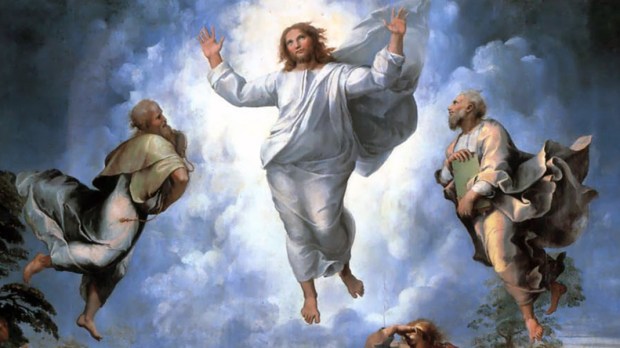You were transfigured on the mountain, and your disciples, as much as they were capable of it, beheld your glory, O Christ our God, so that when they should see you crucified they would understand that your Passion was voluntary, and proclaim to the world that you truly are the splendor of the Father. – Byzantine Liturgy, Feast of the Transfiguration, Kontakion.
The Rosary contains such power because it is a template for the spiritual life. Each time Our Lady leads us through the mysteries we are united to Christ and led to encounter our own frailty. And the mystery of the Transfiguration is the spiritual life in miniature.
After six days Jesus took Peter, James, and John and led them up a high mountain apart by themselves. And he was transfigured before them, and his clothes became dazzling white, such as no fuller on earth could bleach them. Then Elijah appeared to them along with Moses, and they were conversing with Jesus. Then Peter said to Jesus in reply, “Rabbi, it is good that we are here! Let us make three tents: one for you, one for Moses, and one for Elijah.” He hardly knew what to say, they were so terrified. Then a cloud came, casting a shadow over them; then from the cloud came a voice, “This is my beloved Son. Listen to him.” (Mark 9:2-7)
In this mystery Christ draws three apostles very near to himself. As in days of old, the mountaintop becomes a place of closeness with God. Like Abraham and Isaac ascending Mt. Moriah, Moses who ascended Mt. Sinai to receive the Ten Commandments, or Elijah’s experience in the cave on Mt. Horeb, the disciples have gone up with Christ.
The mountaintop is a place to see clearly. In purely natural terms, climbing a mountain allows the landscape below to be seen for what it is. It’s from the mountaintop that the terrain becomes clear.
Pope Benedict XVI says, “The mountain is the place of ascent – not only outward, but also inward ascent; it is a liberation from the burden of everyday life, a breathing in of the pure air of creation; it offers a view of the broad expanse of creation and its beauty; it gives one an inner peak to stand on and an intuitive sense of the creator.”
Christ does not reveal himself in a valley, but on a higher place. We must pour forth our own strength, even as we are moved by Christ’s, to see him at the summit.
What was revealed to the disciples? Christ in all his glory. The Lord’s humanity, during his earthly life, cloaked his divinity. But in this moment the veil was pulled back, and the radiant splendor of his face shown forth. For the disciples, it was a vision as terrible as it was astonishing. It aroused fear, even as Peter voiced the desire to remain in that place.
But the spiritual life cannot be spent on peaks. We must descend. We embark on travels through the valleys. We are sustained by the mountaintop experience. As we face the valleys we know the glory that awaits. The disciples never forgot that vision. Seeing the glory of Christ, they were able to hope in the Resurrection. In the darkest moments of the Passion, they knew because of the Transfiguration the true nature of the Lord of Glory.
Read more:
The Virgin Mary and the Icon of the Unburnt Bush
During the month of October, Aleteia is offering a short reflection on each of the 20 mysteries of the Rosary. Follow it here.

